Numerical Study on Novel Design for Compact Parallel-Flow Heat Exchanger with Manifolds to Improve Flow Characteristics
Abstract
1. Introduction
- Studies on the effects of major shape dimensions such as tube diameter, length, and number of tubes;
- Development of several designs of reduced cross-section along the flow path in the inlet header;
- Use of baffle plates or tubes with different-sized holes along the dividing manifold.
2. Geometrical Details and Numerical Methods
2.1. Model Description
2.2. Governing Equations and Model Assumption
- No phase change or heat transfer occurs inside the compact heat exchangers;
- The density variation is disregarded, and the flow is considered incompressible.
2.3. Grid Dependence
2.4. Model Validation
3. Novel Design and Parameter Study
4. Results and Discussion
5. Conclusions
- When there was a sudden expansion of the cross-sectional area at the inlet of the dividing manifold, a jet flow was induced. This jet flow caused a certain level of flow maldistribution near the entry region owing to the lowest pressure difference between the dividing and combining manifolds.
- A novel design was proposed by combining converging and diverging cross-sectional areas along the dividing manifold. This shape improved the flow uniformity and pressure drop in a system with minimum geometry change, as suggested by other researchers. For U- and Z-types, the flow uniformity index () improved up to 37.46% and 52.00%, respectively, and the non-dimensional total pressure drop improved up to 2.65% and 0.74%, respectively. The worst flow distribution was observed in the first tube; when the novel design was applied, the values of the flow distribution () in the U- and Z-types improved up to 8.60% and 39.95%, respectively.
- The volume flow was 1 lpm of water, equivalent to Re = 5780 based on the inlet tube, thus making it difficult to draw a generalized conclusion. However, as the flow rate increases, it can be predicted that the flow maldistribution will increase due to the change in the jet penetration length at the inlet and the increase in the pressure inside manifolds.
- To obtain the correlation among the parameters of the novel designs, analyses were conducted. As the flow shape factor decreased and the axial installation location moved away from the inlet, the flow uniformity deteriorated. Moreover, as the shape factor increased, the pressure drop also increased. According to the results, some correlations among parameters to improve the characteristics of the system were derived, but the optimized design factors were unclear. Therefore, further consideration will be given to the optimal shape based on objective functions of the flow uniformity index and pressure loss and the manufacturability through 3D metal printing. This will be explored in future research.
Author Contributions
Funding
Conflicts of Interest
References
- Acrivos, A.; Babcock, B.D.; Pigford, R.L. Flow distributions in manifolds. Chem. Eng. Sci. 1959, 10, 112–124. [Google Scholar] [CrossRef]
- Kubo, T.; Ueda, T. On the characteristics of divided flow and confluent flow in headers. Bull. JSME 1969, 12, 802–809. [Google Scholar] [CrossRef]
- Bajura, R.A.; Jones, E.H. Flow distribution manifolds. J. Fluid Eng. 1976, 98, 654–665. [Google Scholar] [CrossRef]
- Choi, S.H.; Shin, S.; Cho, Y.I. The effect of area ratio on the flow distribution in liquid cooling module manifolds for electronic packaging. Int. Comm. Heat Mass Transf. 1993, 20, 221–234. [Google Scholar] [CrossRef]
- Wang, C.C.; Yang, K.S.; Tasi, J.S.; Chen, I.Y. Characteristics of flow distribution in compact parallel flow heat exchangers, part I: Typical header. Appl. Therm. Eng. 2011, 31, 3226–3234. [Google Scholar] [CrossRef]
- Wang, C.C.; Yang, K.S.; Tasi, J.S.; Chen, I.Y. Characteristics of flow distribution in compact parallel flow heat exchangers, part II: Modified inlet header. Appl. Therm. Eng. 2011, 31, 3235–3242. [Google Scholar] [CrossRef]
- Gandhi, M.S.; Ganguli, A.A.; Joshi, J.B.; Vijayan, P.K. CFD simulation for steam distribution in header and tube assemblies. Chem. Eng. Res. Des. 2012, 90, 487–506. [Google Scholar] [CrossRef]
- Huang, C.H.; Wang, C.H. The design of uniform tube flow rates for Z-type compact parallel flow heat exchangers. Int. J. Heat Mass Transf. 2013, 57, 608–622. [Google Scholar] [CrossRef]
- Tong, J.C.K.; Sparrow, E.M.; Abraham, J.P. Geometric strategies for attainment of identical outflows through all of the exit ports of a distribution manifold in a manifold system. Appl. Therm. Eng. 2009, 29, 3552–3560. [Google Scholar] [CrossRef]
- Wang, J. Theory and practice of flow field designs for fuel cell scaling-up: A critical review. Appl. Energy 2015, 157, 640–663. [Google Scholar] [CrossRef]
- Zhang, W.; Hu, P.; Lai, X.; Peng, L. Analysis and optimization of flow distribution in parallel-channel configurations for proton exchange membrane fuel cells. J. Power Sources 2009, 194, 931–940. [Google Scholar] [CrossRef]
- ANSYS Inc. ANSYS Fluent User’s Guide; 275 Technology Drive; ANSYS Inc.: Canonsburg, PA, USA, 2013. [Google Scholar]
- Chen, A.; Sparrow, E.M. Turbulence modeling for flow in a distribution manifold. Int. J. Heat Mass Transf. 2009, 52, 1573–1581. [Google Scholar] [CrossRef]
- Amanowicz, L.; Wojtkowiak, J. Validation of CFD model for simulation of multi-pipe earth-to-air heat exchangers (EAHEs) flow performance. Therm. Sci. Eng. Prog. 2018, 5, 44–49. [Google Scholar] [CrossRef]
- Menter, F.R. Two-equation eddy-viscosity turbulence models for engineering applications. AIAA J. 1994, 32, 1598–1605. [Google Scholar] [CrossRef]
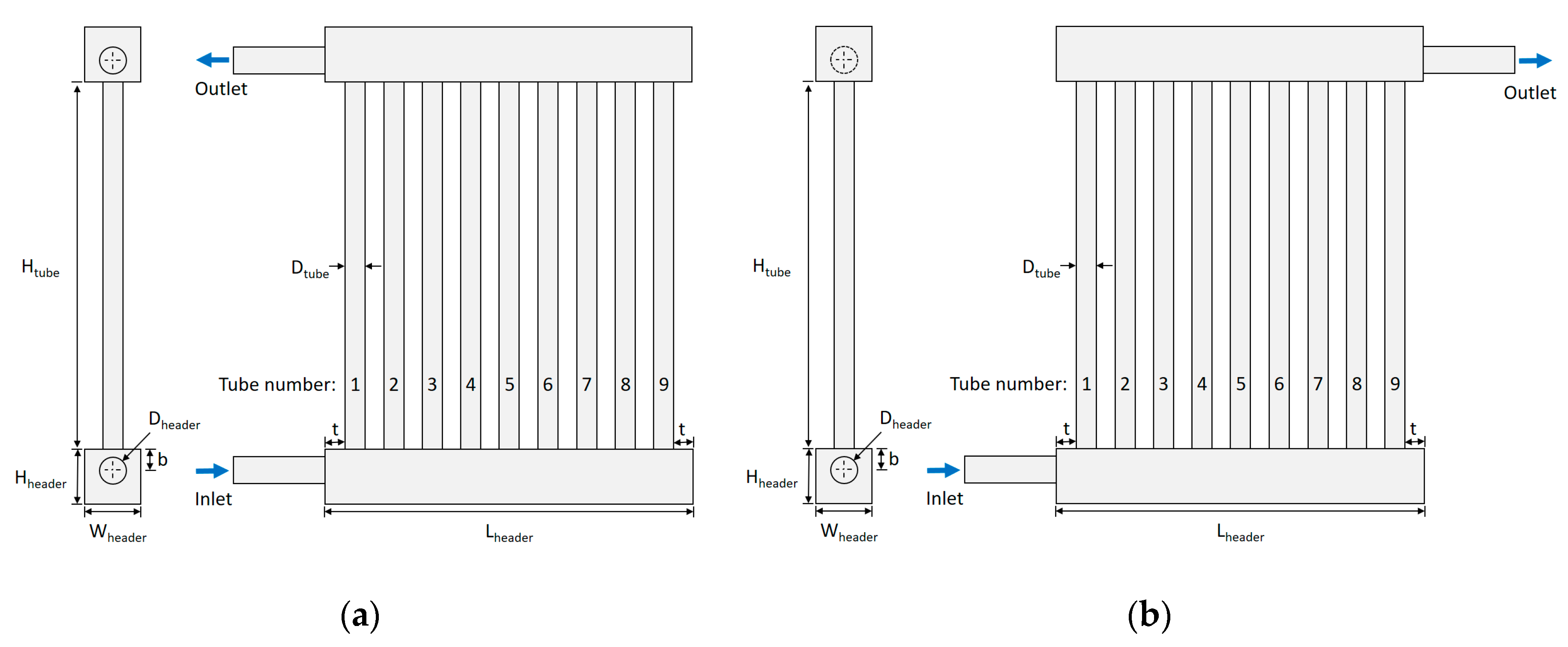
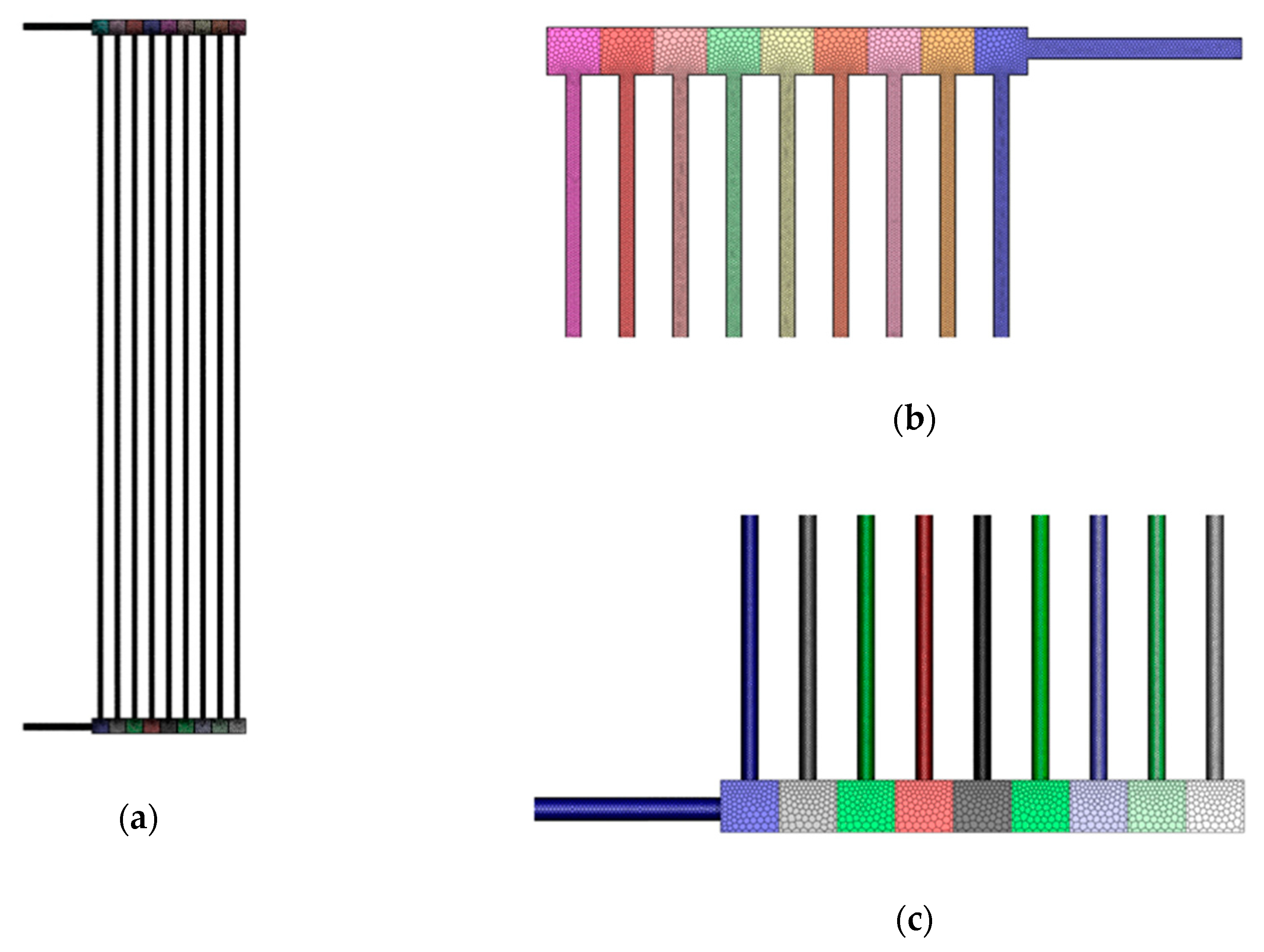


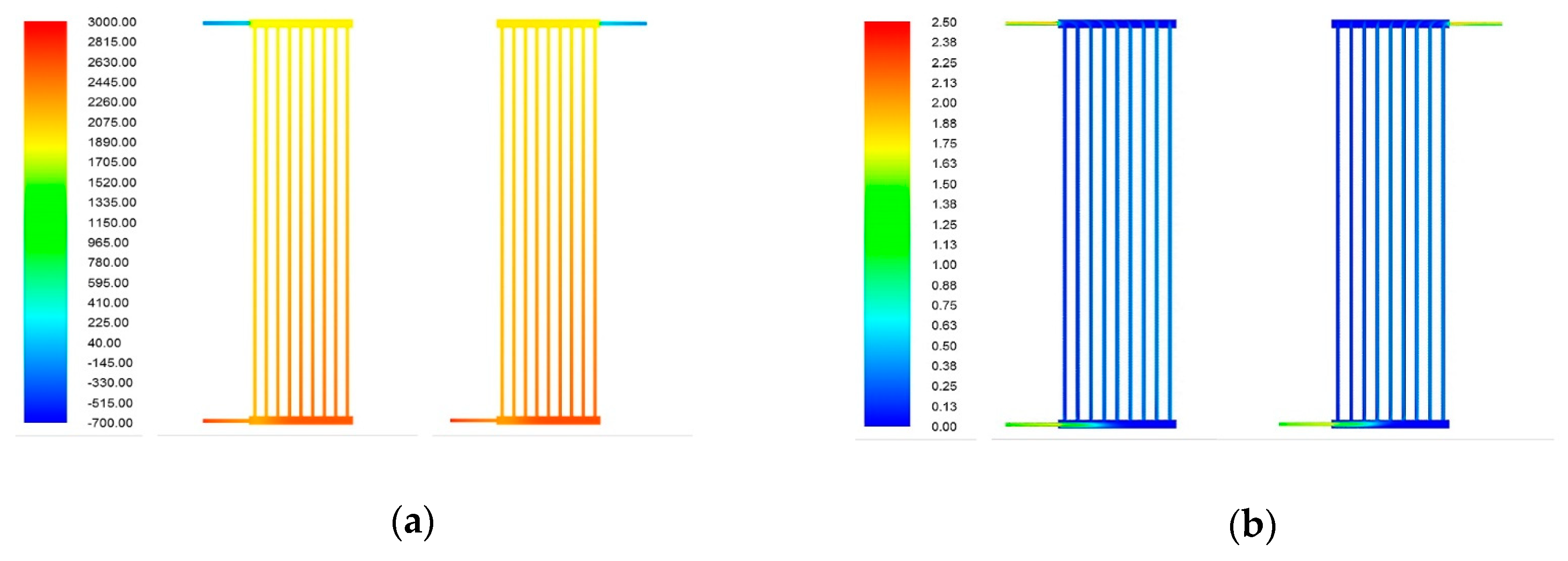
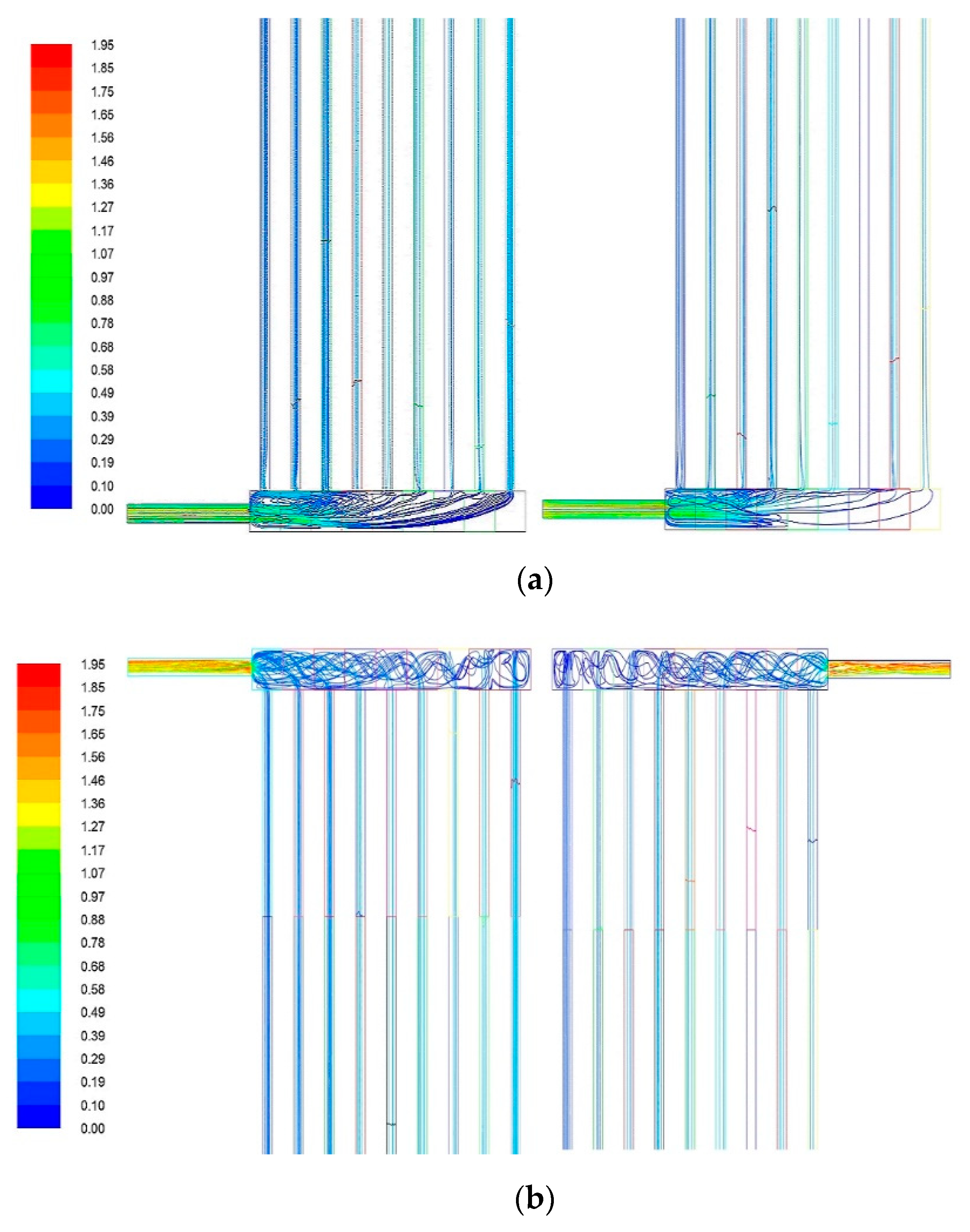
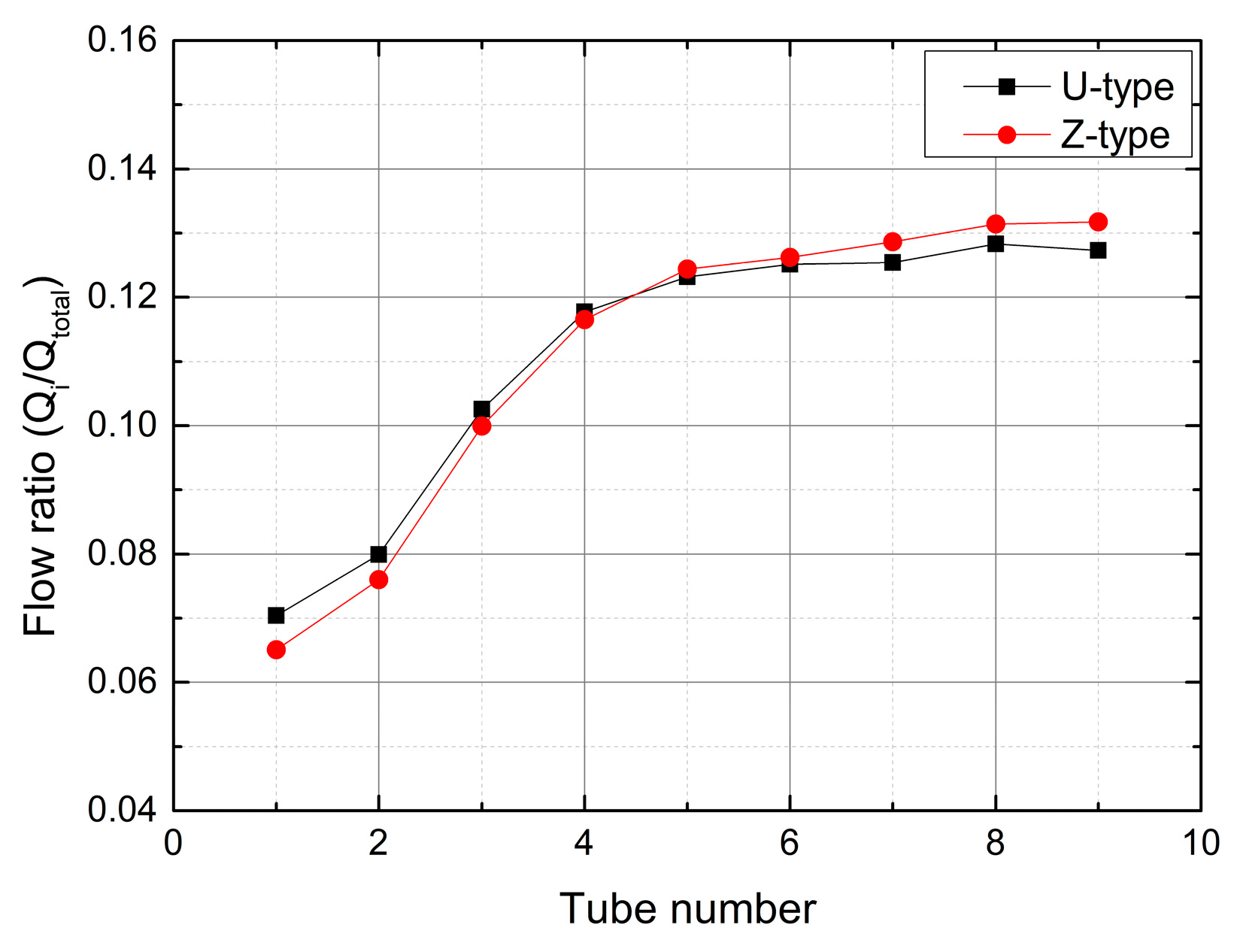

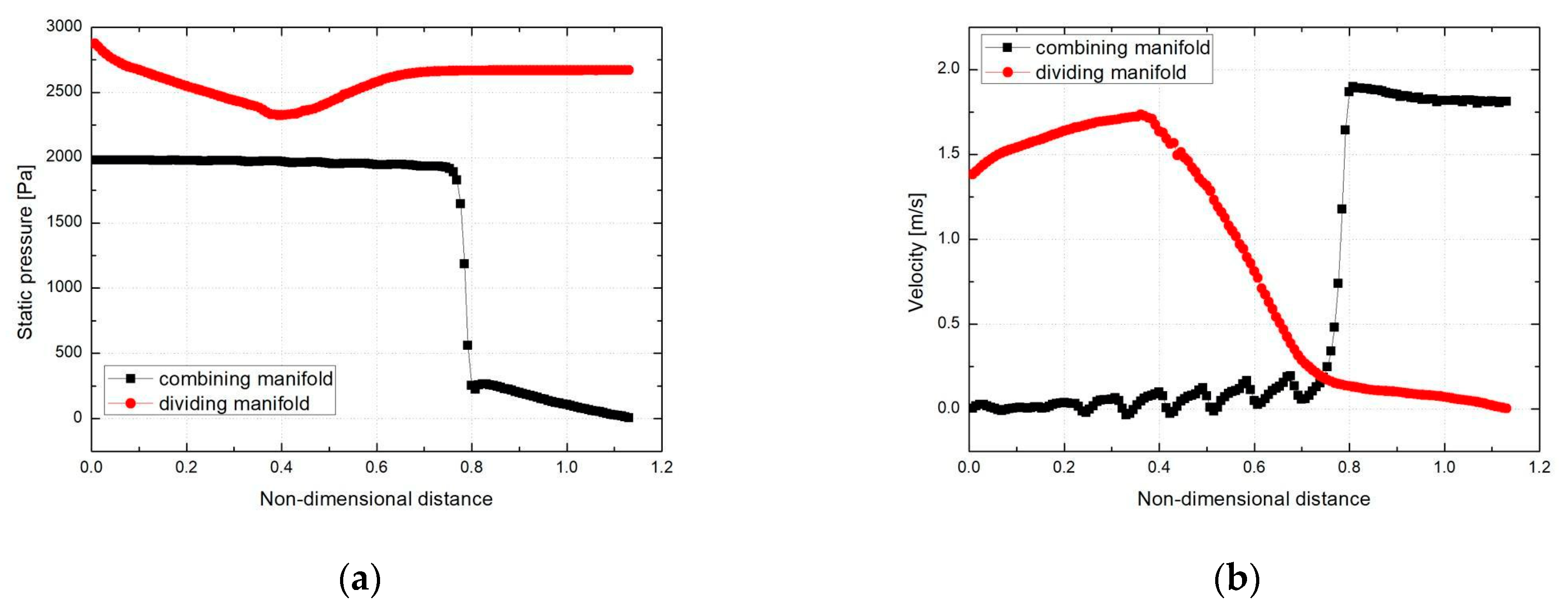
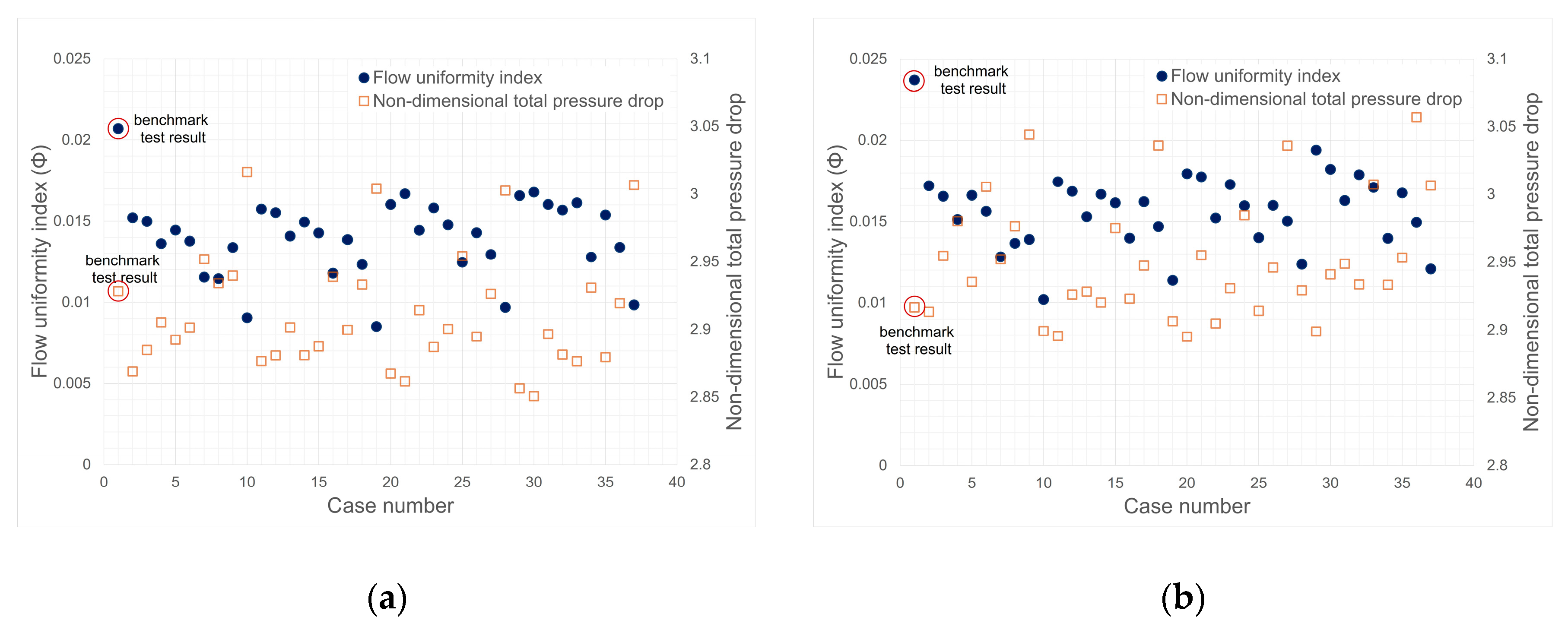
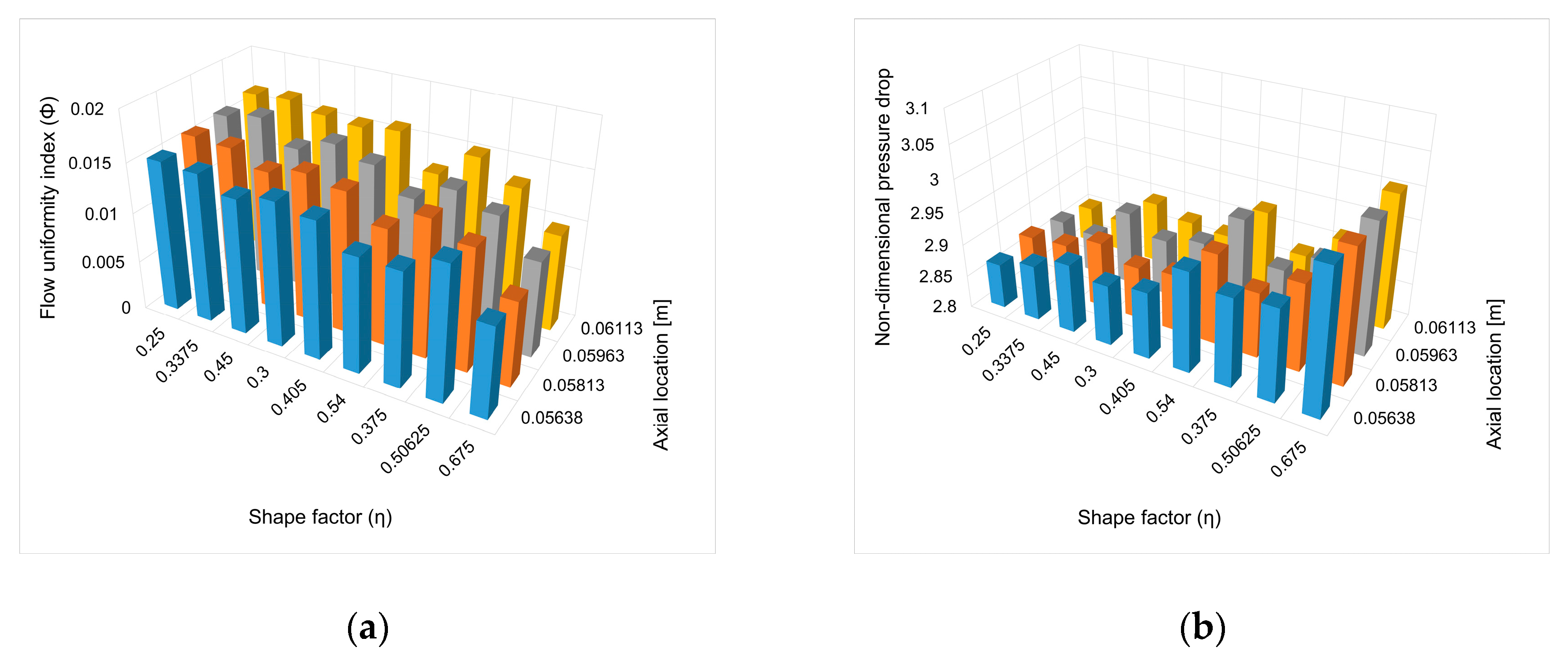
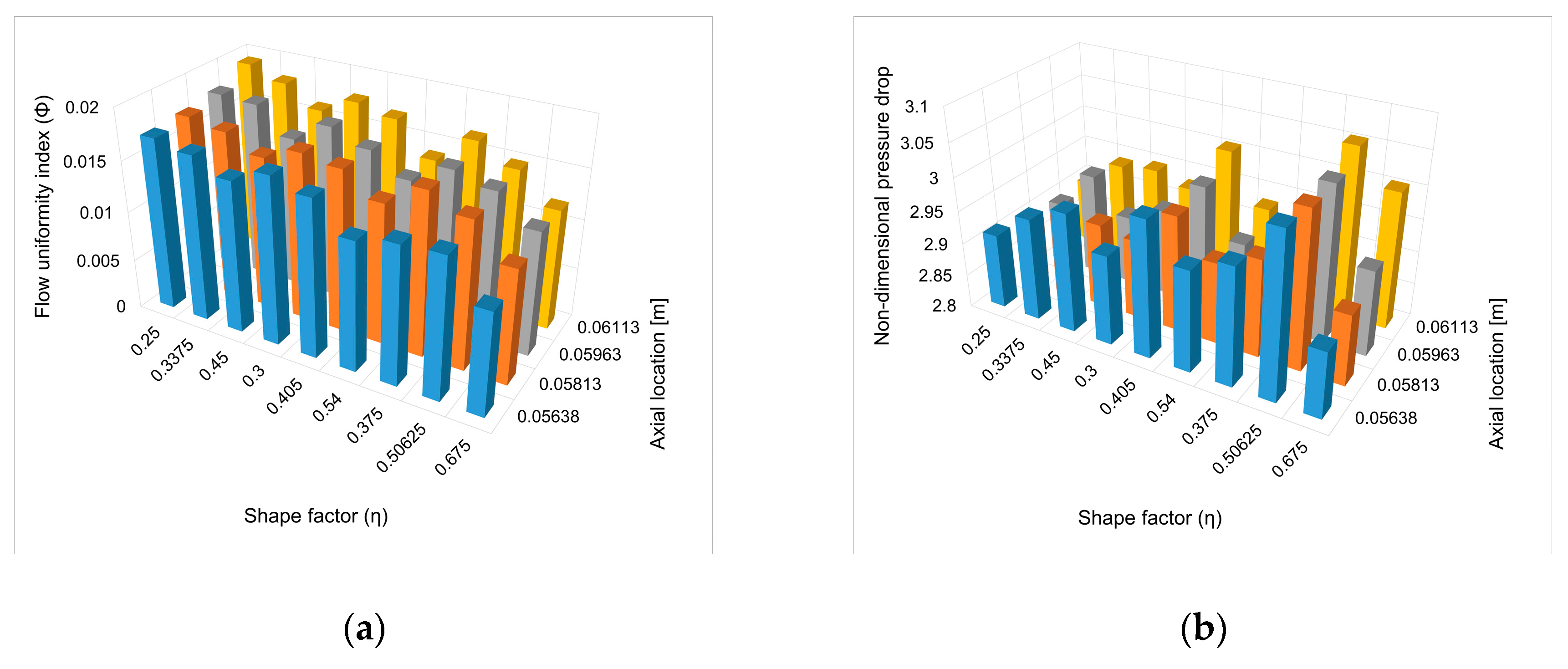
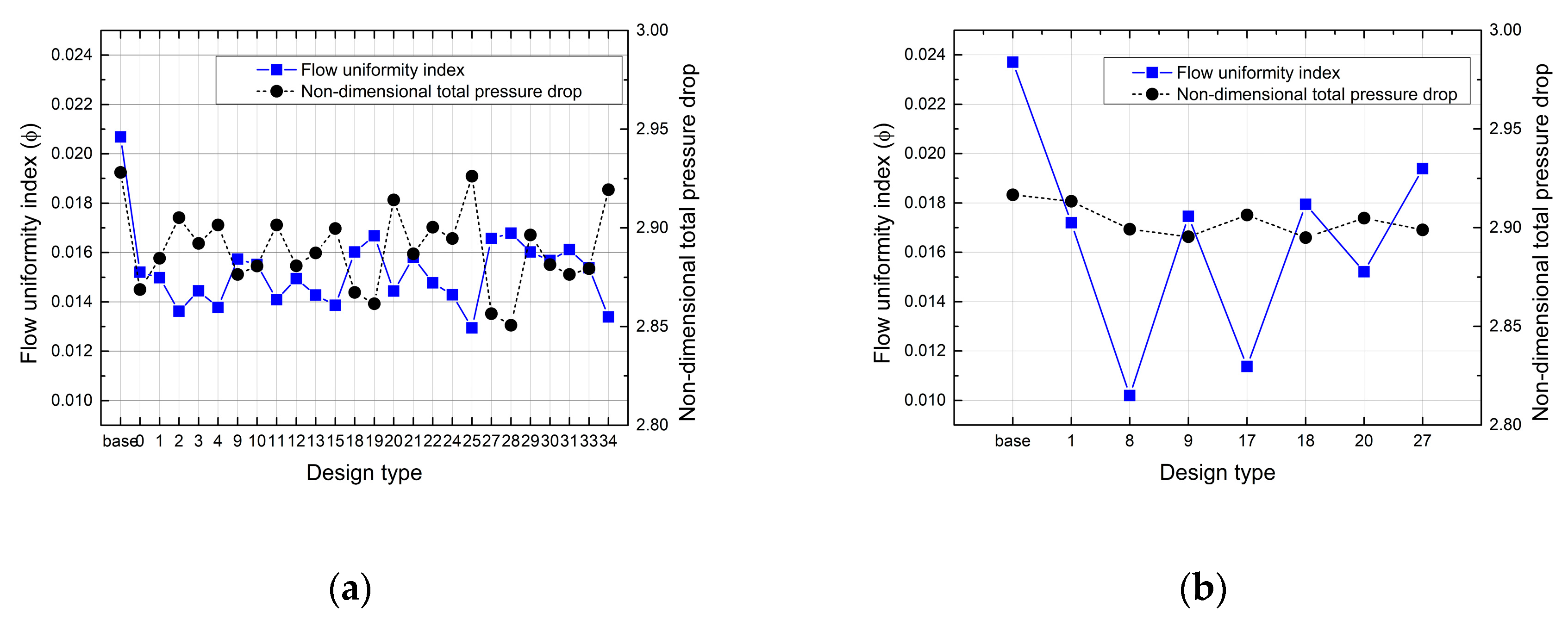
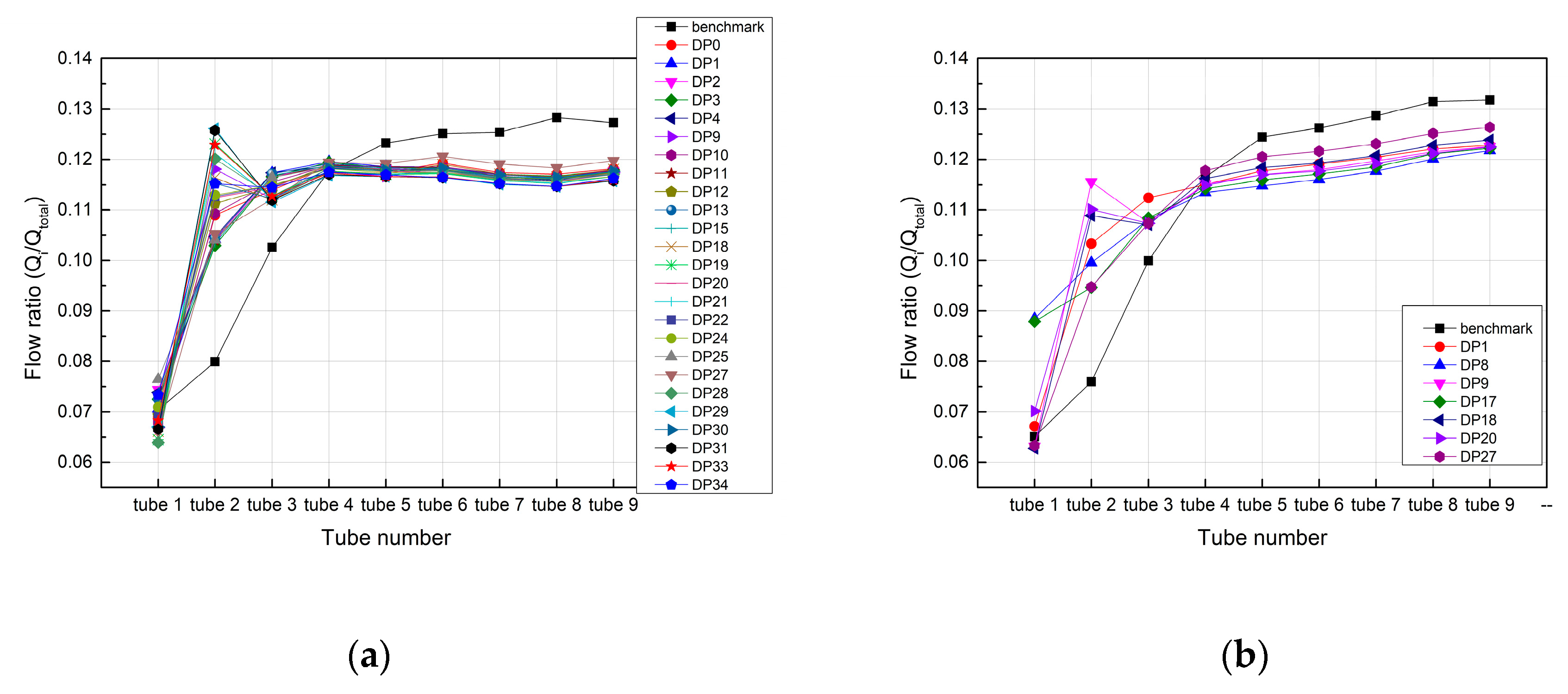
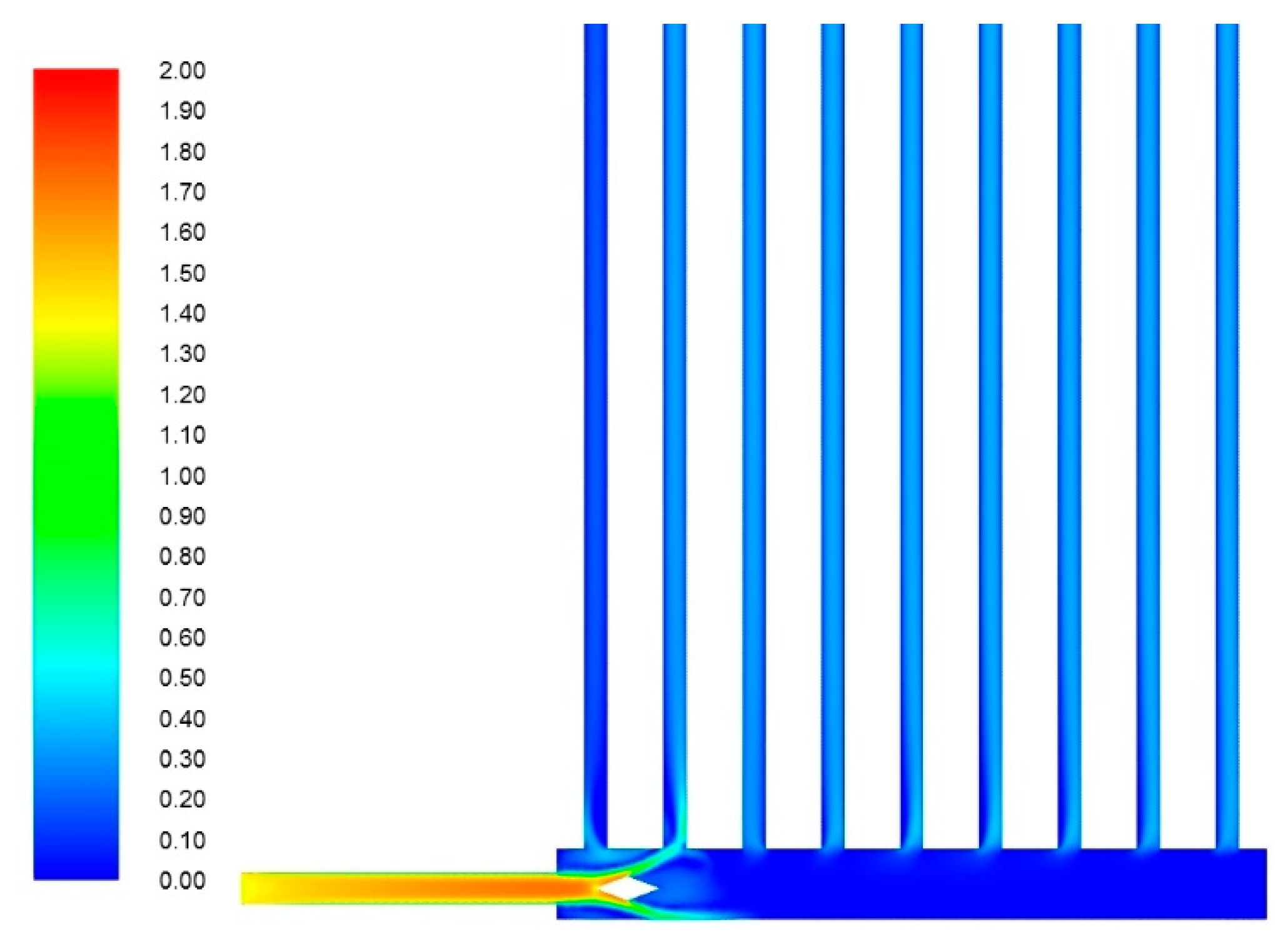
| Dtube | Dheader | Htube | Hheader | Wheader | Lheader | b | t |
|---|---|---|---|---|---|---|---|
| 3 | 4 | 400 | 9 | 9 | 90 | 5 | 3.5 |
| Experiment | CFD | % Error | |
|---|---|---|---|
| U-type | 0.0209 [5] | 0.0207 | 0.96 |
| Z-type | 0.0245 [8] | 0.0237 | 3.27 |
| Parameters | Value 1 | Value 2 | Value 3 | Value 4 | Total Number of Cases |
|---|---|---|---|---|---|
| Laxial | 56.38 | 58.13 | 59.63 | 61.13 | 4 × 3 × 3 = 36 |
| Lquad | 8.00 | 10.00 | 12.00 | - | |
| Hquad | 3.00 | 4.05 | 5.40 | - |
Publisher’s Note: MDPI stays neutral with regard to jurisdictional claims in published maps and institutional affiliations. |
© 2020 by the authors. Licensee MDPI, Basel, Switzerland. This article is an open access article distributed under the terms and conditions of the Creative Commons Attribution (CC BY) license (http://creativecommons.org/licenses/by/4.0/).
Share and Cite
Kim, B.; Kim, K.; Kim, S. Numerical Study on Novel Design for Compact Parallel-Flow Heat Exchanger with Manifolds to Improve Flow Characteristics. Energies 2020, 13, 6330. https://doi.org/10.3390/en13236330
Kim B, Kim K, Kim S. Numerical Study on Novel Design for Compact Parallel-Flow Heat Exchanger with Manifolds to Improve Flow Characteristics. Energies. 2020; 13(23):6330. https://doi.org/10.3390/en13236330
Chicago/Turabian StyleKim, Byunghui, Kuisoon Kim, and Seokho Kim. 2020. "Numerical Study on Novel Design for Compact Parallel-Flow Heat Exchanger with Manifolds to Improve Flow Characteristics" Energies 13, no. 23: 6330. https://doi.org/10.3390/en13236330
APA StyleKim, B., Kim, K., & Kim, S. (2020). Numerical Study on Novel Design for Compact Parallel-Flow Heat Exchanger with Manifolds to Improve Flow Characteristics. Energies, 13(23), 6330. https://doi.org/10.3390/en13236330





